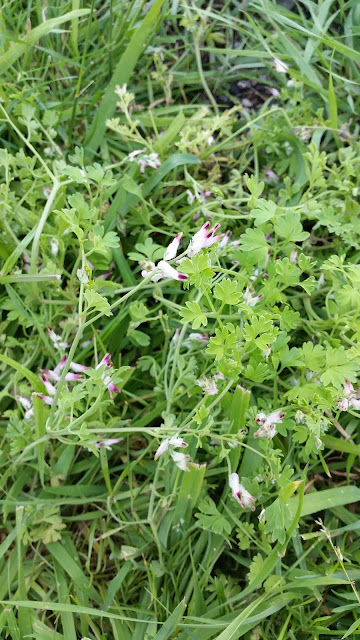You could be forgiven for thinking I was obsessed with stickiness from my last few posts, but yet another sticky plant seemed worth writing about. I delayed writing this post because I was looking for a particular document - which I failed to locate - so I am writing it anyway.
At the end of June I went to look for lichens in the trees at the base of Creag Dubh, near the lochans below Craig Dhu House (and yes they spell it differently). I had foolishly forgotten my insect repellant so did not stay long - too many irritating midges - and I abandoned that spot and went to look at the plants by the lochans instead. I particularly wanted to check on a different kind of sundew, Great Sundew (Drosera anglica), which I had seen several years ago at the edge of the loch but could not find last year. I did find it this year. It grows on the stony ground that is flooded in winter but is exposed when the loch level drops. I have never found it anywhere else.
It differs from the more common Sundew (Drosera rotundifolia) which has round leaves (as its name suggests). This one has elongated spoon shaped leaves.
 |
| Great Sundew (in flower) |
It is still a small plant, just a few centimetres high. like the other sundews, it catches flies.
 |
| A fly stuck to the Sundew - look carefully to see the club shaped projections (halteres) on the thorax |
Two unfortunate flies have become stuck to the sticky drops. I am no fly expert but they may be a kind of midge, and my insect book says that the feathery antennae are just on the males so they can detect the whining noise made by the females. It is just the females that are the bloodsuckers as the males just feed on nectar.
Most insects have 2 pairs of wings - think of dragonflies or butterflies. The term "fly" refers to a class of insects called Diptera which have one pair of wings for flying and the second pair of wings have been reduced to two short club shaped projections. You can see them in the photo near where the wings emerge from the thorax.
I was once more adept at identifying flies. Between leaving school and starting at University, I worked for an engineering firm called Henry Simon that was developing the "Insect-o-cutor". This consisted of a UV light which attracted flying insects which were then zapped by a high voltage grid and fell into a collection tray below. Prototypes were installed into food factories, where they could kill insects without the use of chemicals. I remember a visit to the Paxo Stuffing factory to collect the contents of the tray. My unenviable job was to identify and count the different insects from their frazzled remains. The smell was very distinctive!
The document I was looking for was a press release showing me in my white coat doing that very job....alas, I have been through a lot of folders but haven't yet found it. Watch this space!
















